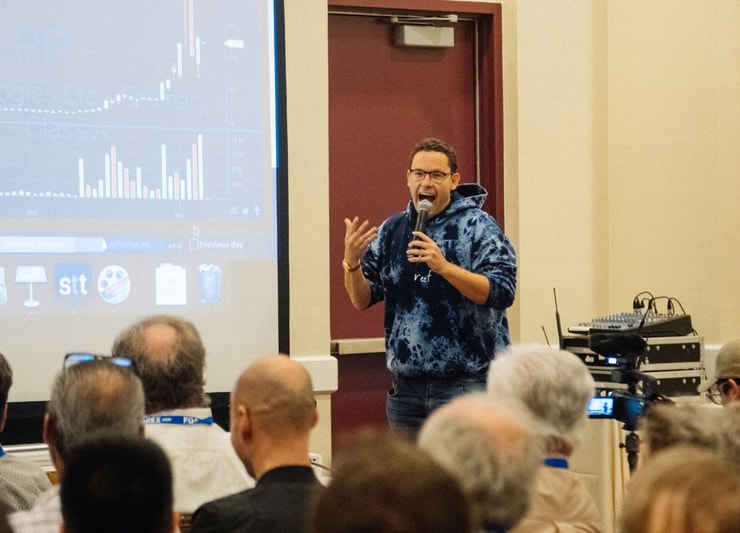When stocks opened up yesterday it didn’t look good.
The Nasdaq was down by more than 2% and the market’s fear index, the VIX, was up by double-digits.
And while I don’t trade “market stocks” I know that 8 out of 10 stocks will follow the broader market.
But that didn’t stop me from buying this weird stock that’s up more than 160% this week.
I’ll show you how I found the play, and why I believe this is the best way to make money buying stocks during a sell-off.
Table of Contents
The State Of The Markets

For weeks now I’ve been telling my students that the Nasdaq is overextended.
Not even I could have imagined it would rally by more than 40% in just seven months.
Yesterday we saw a bit of weakness, and I wouldn’t be surprised if that continues.
But that doesn’t mean you have to be a short-seller to make money.
In fact, some of the best plays I saw were on the long side.
Take for example, the ticker symbol WAVD, which shot up by a whopping 200% in the first hour of the day…
And the ticker symbol IDAI, which shot up by more than 90%
How does one find these types of plays and why do they work so well regardless of what the overall market is doing?
Allow me to explain…
Why Some Stocks Go Up Even When The Market Doesn’t

The key to finding winning plays during a market downturn is to look for catalysts.
Catalysts are new information that can impact the company in either a positive or negative way.
Let’s take the ticker symbol WAVD as an example.
This is a really tiny company, with a market cap in the low 8-figures.
Why does that matter?
A few reasons.
First, Wall Street analysts don’t usually cover stocks this small.
So when news comes out, it isn’t something people could project.
On the other hand, take Apple for example, there are an army of analysts who track the company, watch iPhone sales, and analyze the business to death.
No one is really doing that with small caps.
So when WAVD announced yesterday it was awarded a seven-year contract by a large systems integrator to continue supporting a major financial program for a large U.S. Government customer…and that the company expects total revenues between $12 and $15 million over the course of the contract’s period of performance, guess what happened?
The stock exploded…
Source: StocksToTrade Breaking News
I received several messages from students who spotted this trade and were able to profit from it.
I haven’t been taking pre-market trades, so I didn’t get involved in this trade.
But I did score some nice profits in the ticker symbol IDAI.
And just like WAVD, it was a catalyst driven play.
Source: StocksToTrade Breaking News
And like WAVD, IDAI has a relatively low market cap, and no Wall Street analysts covering the stock.
So when the positive news hit…it was game on.
The headline came in the pre-market and it stated that the company received a privacy-secured biometric identification and verification patent.
I didn’t take it in the pre-market, but I did wait for a sell-off after the open.
I overestimated how powerful this move would be.
The first time I got in at $1.74 and out at $1.86. I jumped in again, this time at $2.12 and out at $2.26. Between the two trades I had a 7.2% winner and a 6.6% winner.
Not bad when you consider most stocks were weak yesterday.
Bottom Line
It is possible to make money even when most stocks are selling. The key is to find stocks that have catalysts. The best way I know how to do that is with the StocksToTrade Breaking News Chat.
Oh and one more thing, none of this wouldn’t be possible without the sacrifice the shorts make.
Take a minute & really appreciate the sacrifice short sellers are making for the rest of us as they destroy their health, sanity & trading accounts so that we may profit on squeezes on $IDAI $AHI $WAVD $AURC $PXDT $TUP it's incredible. Thank you shorts, I will never forget you!
— Timothy Sykes (@timothysykes) August 2, 2023
Need Help?
I’ve helped over 30 of my students go on to become millionaire traders. If you’re looking for someone to help take your trading to the next level, I got you.
Here are two immediate ways I can help:
- Unlock Trading Ideas From Millionaire Traders. Instantly tap into the trading wisdom of seasoned traders. Gain access to some of our top plays at no cost to you. Click here to get started.
- Let Me Be Your Coach. All of my millionaire students went through this program. However, it’s no cakewalk. But if you think you have the passion and dedication needed to become my next millionaire student…then Schedule your Call today and speak to someone from my team.




Leave a reply